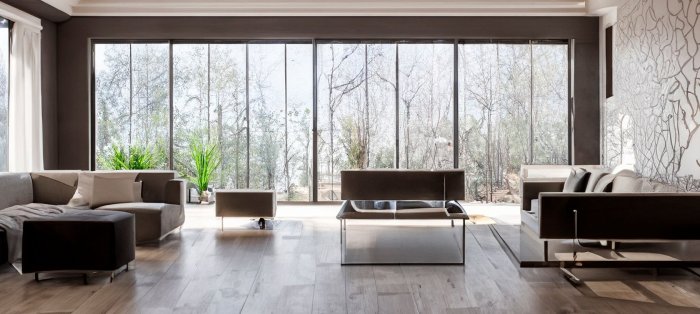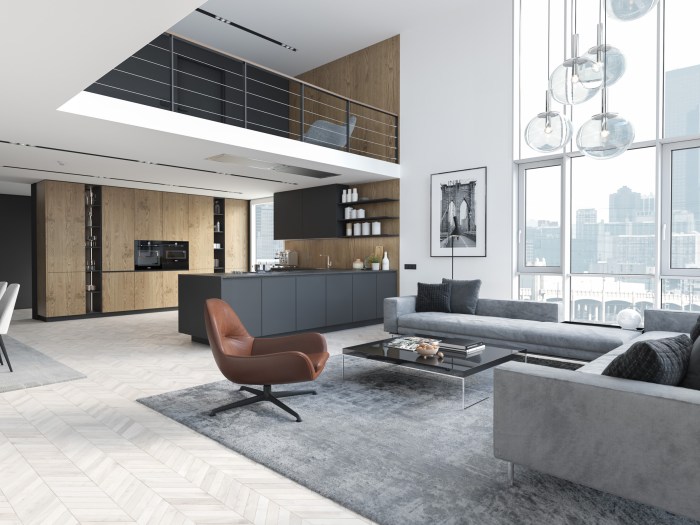Step into the world of modern interior design where sleek lines, minimalist aesthetics, and innovative concepts converge to create stunning living spaces. Dive into this dynamic realm where form meets function, and every corner tells a story of contemporary elegance.
Delve deeper into the essence of modern interior design as we unveil its defining features and unique attributes that set it apart from traditional design styles.
Overview of Modern Interior Design

Modern interior design is a style that emerged in the late 19th century and is characterized by clean lines, minimalism, and a focus on function. This design style prioritizes simplicity, sleekness, and a harmonious blend of form and function.
Key Characteristics of Modern Interior Design
- Minimalism: Modern interior design often features clean, uncluttered spaces with minimal decorative elements.
- Neutral Color Palette: Colors in modern interior design are typically neutral, with pops of bold color used sparingly.
- Open Floor Plans: Spaces are designed to be open and interconnected, promoting a sense of flow and spaciousness.
- Use of Natural Materials: Modern interiors often incorporate natural materials like wood, stone, and metal for a sleek and organic look.
- Emphasis on Functionality: Furniture and decor in modern interior design are chosen for their practicality and efficiency.
Comparison with Other Design Styles
Modern interior design is often confused with contemporary design, but they are distinct styles. While modern design refers to a specific period in history (late 19th to mid-20th century), contemporary design is ever-evolving and reflects current trends and influences. Additionally, modern design is characterized by a more minimalist and structured approach, while contemporary design allows for more flexibility and experimentation.
Color Schemes in Modern Interior Design
When it comes to modern interior design, color schemes play a crucial role in setting the tone and ambiance of a space. Whether you're aiming for a minimalist look or a bold statement, the colors you choose can make a significant impact on the overall design.
Popular Color Schemes in Modern Interior Design
Modern interior design often incorporates the following popular color schemes:
- Monochromatic: Using varying shades of a single color creates a sleek and cohesive look.
- Neutral with a Pop of Color: Neutral tones like whites, grays, and beiges are paired with a vibrant accent color to add interest.
- Complementary Colors: Colors that are opposite each other on the color wheel, such as blue and orange or purple and yellow, create a dynamic and energetic feel.
- Analogous Colors: Colors that are adjacent to each other on the color wheel, like green and blue or red and orange, provide a harmonious and calming effect.
Incorporating Bold Colors in Modern Interior Design
Adding bold colors to a modern interior can make a striking statement and infuse personality into the space. Here are some ways to incorporate bold colors:
- Accent Walls: Painting one wall in a bold color can create a focal point without overwhelming the entire room.
- Furniture and Accessories: Incorporating bold-colored furniture pieces or decorative accessories can add a pop of color to a neutral space.
- Artwork: Hanging vibrant artwork on the walls can inject color and visual interest into a modern interior.
- Textiles: Using bold-colored rugs, curtains, or throw pillows can instantly liven up a room and tie the design together.
Furniture and Decor Elements
Modern interior design often features furniture pieces that are characterized by clean lines, sleek finishes, and a focus on functionality. These pieces are typically simple yet sophisticated, with an emphasis on minimalism and creating a sense of space and openness within the room.
Typical Furniture Pieces in Modern Interior Design
- Sleek and minimalistic sofas and chairs with straight lines and neutral colors
- Low-profile coffee tables and side tables made of materials like glass, metal, or wood
- Storage solutions such as floating shelves, built-in cabinets, and minimalist shelving units
- Statement pieces like accent chairs, artistic lighting fixtures, and unique sculptures
Influence of Minimalist Design on Furniture Choices
Minimalist design plays a crucial role in shaping furniture choices in modern interiors
Role of Decor Elements in Modern Design
Decor elements such as lighting, art, and accessories are essential in adding personality and character to modern interiors. Lighting fixtures can serve as focal points and enhance the ambiance of the room, while carefully curated art pieces can create visual interest and tie the design together.
Accessories like throw pillows, rugs, and plants can inject color and texture into the space, adding warmth and depth to the overall design.
Materials and Textures

In modern interior design, the choice of materials and textures can significantly impact the overall look and feel of a space. By carefully selecting and combining different materials, designers can create a cohesive and visually appealing environment.
Common Materials Used in Modern Interior Design
- Glass: Glass is a popular choice in modern design for its sleek and transparent qualities. It can be used for windows, doors, partitions, and even furniture pieces.
- Metal: Metals like steel, aluminum, and copper are often incorporated into modern interiors for a contemporary and industrial look. They can be used for structural elements, decorative accents, and furniture.
- Wood: Wood is a versatile material that adds warmth and texture to modern spaces. It can be used for flooring, cabinetry, furniture, and decorative features.
Role of Textures in Modern Interiors
Textures play a crucial role in modern interior design by adding depth, visual interest, and tactile appeal to a space. Combining different textures such as rough vs. smooth, matte vs. glossy, and soft vs. hard can create a dynamic and layered environment.
Tips for Mixing Materials and Textures
- Start with a neutral base: Begin with a neutral color palette and then add in materials and textures for contrast and visual impact.
- Balance is key: Mix a variety of textures but ensure there is a balance between rough and smooth, shiny and matte, and soft and hard surfaces.
- Consider the overall style: Choose materials and textures that complement the overall style of the space, whether it's modern, minimalist, industrial, or eclectic.
- Layer textures: Layering textures through textiles, furniture, accessories, and finishes can create a rich and inviting atmosphere.
Last Word
As we conclude our exploration of modern interior design, we leave you with a newfound appreciation for the harmonious blend of style and functionality that defines this captivating design approach. Embrace the spirit of modernity in your living spaces and witness the transformative power of cutting-edge design.
FAQ Resource
What defines modern interior design?
Modern interior design emphasizes clean lines, simplicity, and functionality, incorporating innovative materials and technologies to create sleek and sophisticated spaces.
How does color impact modern interior design?
Colors in modern interior design are often used strategically to evoke certain moods or highlight architectural elements, with popular choices including neutral palettes and bold accents.
What role do decor elements play in modern design?
Decor elements such as lighting, art, and accessories add personality and depth to modern interiors, enhancing the overall aesthetic and creating a cohesive look.
How important are materials and textures in modern interior design?
Materials like glass, metal, and wood are commonly used in modern design to add visual interest, while textures play a crucial role in adding tactile appeal and creating a sense of warmth in contemporary spaces.
